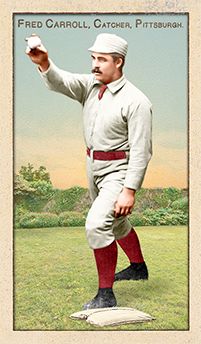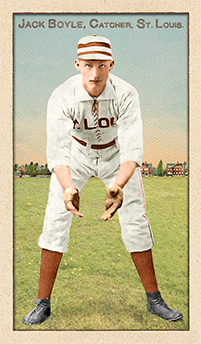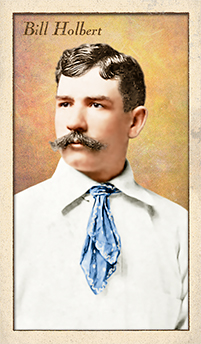
- Series: Beginnings: 1880's
- City: Pittsburgh
- Team: Alleghenys
- League: National League
Frederick Herbert Carroll (1864-1904) was born in Sacramento and, per Bill James, never really adjusted to life in the East. James touts Carroll as perhaps the finest “young” catcher, not only of his era, but until the arrival of Johnny Bench. Fred was nineteen when he started for the Columbus Buckeyes of the American Association. He moved on to spend seven more years in MLB for three Pittsburgh franchises in the AA, NL and Players' League. During this fairly brief tenure, Carroll twice hit over .300 and twice was among the league leaders in home runs. His career average of .284 justifies James' assessment of the rare hitter with power at catcher. Hall of Famer Buck Ewing set the standard for 19th century catchers, but Carroll was as solid as they come. Carroll had quite a year in 1886 with the Alleghenys. He set career marks in hits, doubles, triples and runs. And he also faced a club suspension for fighting teammate Otto Schomberg. Team owners, perhaps realizing how disliked Schomberg was, quickly ended Carroll's exile and lowered his fine to $50. The following season Fred became the first Pittsburgh player to hit for the cycle.
- In 1889 Carroll led the league in on-base percentage and slugging, said by the Encyclopedia of Baseball Catchers to be a record production for a catcher of that age (24)
- Carroll left the Steel City for his home state, playing for Oakland and SF in the minors
- Carroll's uniform color on this card was changed in February, 2017 from blue to red to reflect recent reliable research by Craig Brown & friends at Threads of Our Game. One card had been previously released featuring a blue uniform.
- Series: Beginnings: 1880's
- City: St. Louis
- Team: Browns (AA)
- League: American Association
John Anthony Boyle (1866-1913) debuted with the Red Stockings in 1886 for one game before being traded to Comiskey’s Browns. Jack became their regular catcher when Doc Bushong got hurt. Comiskey then took Boyle with him to the Players’ League Chicago Pirates for the 1890 season and then back to St. Louis when that venture collapsed. Sold to NY in ‘92, Jack became the “giant” of the team at 6’4”. The Giants used Jack and others to reclaim HOF’er Roger Connor from the Phillies the following year. Boyle finished his ML tenure with the Phils where he had his best years at bat. As he gained experience behind the plate, Jack’s defense measured up to his strong offense.
- Boyle compiled a career .253 average and fielded .929 overall, mostly as a durable catcher
- Per SABR, “Honest Jack’s” trade to the Browns was the very first in the major leagues

- Series: 1880s: Spotted Ties
- City: New York
- Team: Metropolitans
- League: American Association
Charles W. Reipchlager (aka Ripslager) (1856-1910) was a reserve catcher, playing the one position that didn't require an ability to hit the curve, just corral it. His major league tenure was primarily with the New York Metropolitans, beginning in 1883. He lasted four seasons as a partner with Bill Holbert, himself a light-hitting but capable receiver.
Charlie moved on to the Cleveland Blues for the '87 season where he labored in 63 games and batted .212. He would try one more time to escape the minors. He signed with the Brooklyn Gladiators for the upcoming 1890 season, only to be released before the campaign began. The Gladiators would go on to a 26-73 record that year which must have convinced Reipschlager that the majors were simply out of reach.
Reipschlager and Holbert were working behind the plate during an era of rapid change in pitching distances and pitching technique. The National League loosened the requirements for the pitching motion in 1884 but the Metropolitans' American Association didn't follow suit until mid-way through the '85 campaign. In 1886 both leagues lengthened the pitcher's “box” and placed a flat stone at the front of it to allow the umpire to police the pitcher's adherence to the defined space. The “mound” would await the 20th century's innovations.
- Reipschlager's career batting average was a meager .222, but he earned his keep in an era when short distances from the pitcher's “plate” to home made it perhaps more challenging to catch than to hit
Auction History
Cartophilia
Old Judge Pose: 386-1
- Series: 1880s: Spotted Ties
- City: New York
- Team: Metropolitans
- League: American Association
William Henry Holbert (1855-1935). Holbert was a catcher for 6 teams over 12 seasons and is perhaps best known as the player with the most career at bats without a home run (2,335). While a good defender, Bill was a weak hitter compiling a career BA of .208, with .228 OBP, .232 SLG, and an OPS+ of 47.
- One of the original umpires of the Player’s League in 1890
- Of his 486 hits, only 48 were for extra bases
Auction History
Cartophilia
Old Judge Pose: 230-1

- Series: Beginnings: 1880's
- City: Chicago
- Team: White Stockings
- League: National League
Conrad Darling (1861-1904) was a modest-hitting journeyman catcher knocking around the hard-scrabble baseball towns of western Pennsylvania when The Sporting Life took note of his work following the 1886 season: “Darling was undoubtedly the most valuable man behind the bat in the International League.” Suddenly, Dell was in demand, spurning an offer from Jim Mutrie’s Giants and signing with Cap Anson’s Colts. He played well but sporadically until trying his fortune with Comiskey’s Chicago Pirates in the 1890 Players’ League. His career was in steep decline, likely due to the usual toll of catching in the big leagues. Dell played only part time for the Browns in ‘91 before hanging ‘em up. He did gain a short bit of notoriety by being implicated in a massive scheme to rob moving trains. He and other ballplayers were accused of pilfering baggage and tossing the spoils to confederates trackside. The publicity faded shortly with no indictment.
- The origin of Darling’s nickname is unknown but stayed with him through his obituary
- It was speculated that an old baseball injury contributed to Dell’s early demise
- Darling's uniform color in this card was changed from black to blue in March, 2017 to reflect recent reliable research conducted by Craig Brown and friends at Threads of Our Game. One card had been previously released featuring a black uniform.




